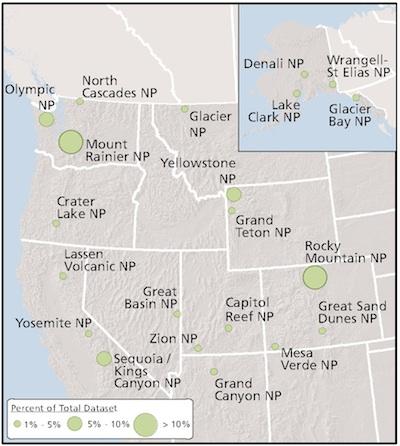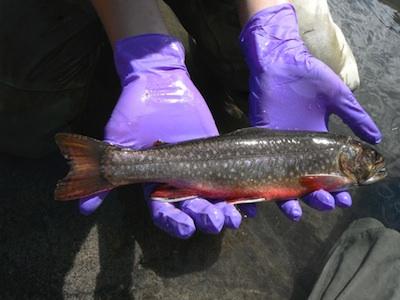Timing often is happenstance, but with Earth Day arriving next week, word of high mercury levels in fish in national parks from Alaska to Colorado is particularly sobering. In some cases, the levels exceed limits OKed for human consumption.
One fish sampled for the study, taken from Yosemite National Park in California, had mercury levels of 950 parts per billion, "at which no human consumption is advised," said the report produced by the U.S. Geological Survey and the National Park Service.
All 21 parks included in the four-year survey, from Denali National Park and Preserve in Alaska to Rocky Mountain National Park in Colorado, had fish with varying levels of mercury. Concentrations ranged from 9.9 parts per billion to 1,109 parts per billion, with a mean of 77.8 parts per billion.
'Unfortunately, mercury and other forms of pollution don't recognize park boundaries. Even our nation's most pristine places like our national parks are vulnerable to toxic pollution," said Sarah Gaines Barmeyer, director of Conservation Programs for the National Parks Conservation Association in an email.
"When you visit national parks, you expect to see the best of what America has to offer, which should not include fish consumption advisories. This makes the USGS study particularly concerning. NPCA supports efforts to reduce mercury pollution from coal plants and other industries that contaminate park air and water.'

Spatial distribution of the 21 national parks sampled in this study. Size of circle represents percentage of total dataset.
While only 5 percent of the nearly 1,500 fish sampled had mercury concentrations exceeding a benchmark of 200 parts per billion that elicits toxic responses in fish, 35 percent of the samples had mercury levels above 90 parts per billion, high enough to impact some birds, and mercury levels in 68 percent of the fish "were above exposure levels recommended by the Great Lakes Advisory Group for unlimited consumption by humans," the study said.
"Zion, Capital Reef, Wrangell-St. Elias, and Lake Clark national parks all contained sites in which most fish exceeded benchmarks for the protection of human and wildlife health," the report's abstract noted. "This finding is particularly concerning in Zion and Capitol Reef national parks (in Utah) because the fish from these parks were speckled dace, a small, invertebrate-feeding species, yet their mercury concentrations were as high or higher than those in the largest, long-lived predatory species, such as lake trout."
Interestingly, just as the researchers found varying mercury levels from park to park, some fish samples taken within a single park had wide swings in the levels.
"The greatest range in site-specific geometric mean fish (total mercury) concentrations within parks occurred in Mount Rainier (in Washington state) and Rocky Mountain (in Colorado) national parks, where we measured approximately 11- and 8-fold differences, respectively, between the sites within each park with the lowest and highest (total mercury) concentrations," the researchers noted.
The sampling found that while Grand Teton (in Wyoming) and Great Basin (in Nevada) national parks "had the lowest proportion of fish exceeding the (Great Lakes Advisory Group) unlimited consumption threshold (18 percent), ... 100 percent of fish analyzed from Glacier National Park (in Montana) exceeded this threshold."
Overall, though, 14 of the 21 parks involved in the survey "did not have any fish in exceedance of the 300 parts per billion EPA fish tissue criterion," the report said. "Conversely, for those parks with fish that did exceed ecological and human health benchmarks, a substantial proportion of the fish had concentrations that were above those thresholds of concern."
Some fish in Wrangell-St. Elias National Park and Preserve and Lake Clark National Park and Preserve, both in Alaska, exceeded thresholds recommended by both the State of Alaska and the Environmental Protection Agency for unlimited human consumption by women and children, a Park Service release said.
State of Alaska human consumption thresholds start at 150 parts per billion. Lake trout, with average concentrations as high as 417 parts per billion, were found in one lake in Wrangell-St. Elias National Park and Preserve. The average concentration in lake trout in Lake Clark was 365 parts per billion. Mercury levels were low in Denali National Park and Preserve and Glacier Bay National Park and Preserve.

One of the brook trout sampled at Mount Rainier National Park./USGS, Collin-Eagles Smith.
Park Service officials in Alaska noted that "Lake trout are a relatively long-lived fish species at the top of the food web, and as such are more likely to accumulate mercury and other toxins over their lives than other species of fish. They are not consumed in great quantities by either sport or subsistence fishermen so the risk to people is likely low, but variable given location and frequency of fish consumption. The extent of the effects on fish-eating birds and mammals that depend on lake trout for survival is unknown."
A joint press release from the USGS and Park Service pointed out that the Park Service "is coordinating with state officials in the 10 study states regarding potential fish consumption advisories. State fish consumption guidelines consider both the risks associated with mercury exposure and the benefits of fish consumption, such as improved cardiac health from increased omega-3 fatty acid consumption or potential reduced intake of unhealthy fats due to food substitutions."
According to the paper, mercury is "among the most widespread" of environmental contaminants, coming from both natural sources (volcanic eruptions), and manmade sources (coal-fired power plants as well as historic and current mining activities). "more than 16 million lake acres and 1 million river miles are under fish consumption advisories due to mercury contamination in the United States, and 81 percent of all fish consumption advisories were issued because of mercury contamination," it notes.
The study, 'Mercury in fishes from 21 national parks in the Western United States ' Inter and intra-park variation in concentrations and ecological risk,' is available here. Within its pages you can find breakouts on the 21 individual parks.
Additional information on mercury pollution in national parks can be found here.



Comments
rmackie,
No doubt we need to be sensitive to environmental issues. But, we must make sure the "solution" is proportional to the problem. Taking intrusive steps that have no real impact can only hurt the cause.
This is another good example of "there's a lot we don't know...and expert opinions differ." A report, "Geologic studies of mercury by the U.S. Geological Survey" by John E. Gray cites a study that says "...mercury emissions from volcanoes probably account for less than one percent of the total global contribution of mercury to the atmosphere." That data appears to be from the mid-1980s. Has the mercury from volcanoes situation changed so dramatically in 30 years - or are various estimates of sources of mercury too high or too low? http://pubs.usgs.gov/circ/2003/c1248/
Mercury from volcanoes is obviously something beyond our control, so it's reasonable to ask some questions about things we can control in the U.S.: (1) Does mercury at some levels in the food chain pose human health concerns? (2) That answer seems to be "yes," so would reducing mercury deposition from human activities in the U.S. reduce those risks in the U.S. to whatever constitutes "acceptable' levels? (3) If so, are we willing to pay the associated costs to make those reductions?
It's a complex issue, and even a brief web search will find answers literally all over the map. One problem is that other nations, primarily China, are bigger contributors than U.S. sources to the problem of mercury deposition in the global environment, largely as a result of China's rapid increase in the amount of coal burned to produce electricity.
Estimates I found online of the amount of mercury deposited in the U.S. from domestic, man-caused sources range from 66% down to about 22%. Coal-burning power plants are widely cited as the largest human-caused source (over 50%) of mercury emissions to the air in the United States.
Would proposed regulations to further reduce mercury released from burning coal in the U. S. also result in a reduction in other pollutants, such as nitrogen oxide? I don't know, but if so, those benefits might even outweigh the mercury issue. If that's the case, perhaps the mercury concerns, even if overblown, could be the catalyst to solve other problems related to coal-fired plants that lack best available technology. http://www.psr.org/resources/coals-assault-on-human-health.html
Just one example of specific park-related effects of coal plants is the Navajo Generating Station in the Four Corners area. http://www.npca.org/news/media-center/press-releases/2014/clean-air-advo...
Other sources:
http://www.ucsusa.org/clean_energy/coalvswind/c02c.html
http://www.epa.gov/mats/powerplants.html
http://www.sciencemag.org/content/257/5071/784.abstract
http://www.forbes.com/sites/kensilverstein/2013/03/20/coal-plants-belchi...
http://www.newmoa.org/prevention/mercury/mercurylake.pdf
Jim,
Here are a few more online links regarding guidlines on mercury in fish:
http://water.epa.gov/scitech/swguidance/fishshellfish/outreach/advice_in... (web page and link to PDF brochure)
http://water.epa.gov/scitech/swguidance/fishshellfish/outreach/upload/20...
http://water.epa.gov/scitech/swguidance/fishshellfish/outreach/upload/20...
http://water.epa.gov/scitech/swguidance/fishshellfish/fishadvisories/ind...
http://www.fda.gov/food/foodborneillnesscontaminants/metals/ucm115644.htm
http://tennessee.gov/twra/fish/contaminants.html
http://www.cvent.com/events/2014-national-forum-on-contaminants-in-fish/...
Regardless of whether the source of mercury is natural or anthropogenic, what the NPS must decide is this: At what point are the concentrations reported in park fish sufficiently high that fish advisories are necessary to warn the public of the potential hazard? In formulating a decision about the possible need for such advisories, distinctions need to be made between those who frequently catch and consume park fish and those who do so only sporadically. For most individuals and most parks, the majority of a person's annual intake of fish will be from locations outside the park? Of course, these fish may also have residual levels of mercury in their tissue.
Health advisories are not normally based on the mercury concentration in a single fish, but on estimates of the total amount of fish and mercury consumed within the time frame of one or more years, normalized to the body weight of the individual. Thus, intake limits for children are more restrictive than intake limits for adults.
The most toxic form of mercury is methyl mercury. Most of the mercury that is detected in fish tissue has been biologically converted to methyl mercury.